Visual Guide to Install Red Hat Enterprise Linux (RHEL)
Red Hat Enterprise Linux is a commercial open-source Linux distribution developed by Red Hat for the business market. Visual Guide to Install Red Hat Enterprise Linux (RHEL) is what you will review in this guide. Thousands of vendors and hundreds of clouds have certified RHEL, formerly known as Red Hat Linux Advanced Server.
RHEL used to be free to use, with users only required to cover support costs. Red Hat, however, has now produced two variations of RHEL. One is a version that is updated less frequently. The Fedora Project’s Fedora is the alternative. It features the most recent technologies and has more frequent version updates.
You can buy cheap Linux VPS and run Red Hat on it to use a range of workloads in physical, virtual, and cloud environments.
What is Red Hat Enterprise & Why Choose it for Linux?
RHEL is renowned for reducing deployment costs associated with friction and quickening the time to value essential workloads. This strategy enables development and operations teams to collaborate and innovate in a seamless manner across corporate contexts. The Linux kernel and a number of specialized apps are both included in RHEL. Oracle Linux, Pie Box Enterprise Linux, CentOS, and Scientific Linux are a few notable Linux distributions descended from RHEL. Several technologies are supported and powered by RHEL. They include management software, cloud computing, containers, middleware, storage, microservices, automation protocols, and application development tools.
Commercial enterprise Linux distribution RHEL is accessible via subscription. Patches, bug fixes, upgrades, and technical support are provided to customers. In addition to having built-in manageability and integration with the larger Red Hat administration and automation portfolio, Red Hat Enterprise Linux offers you a dependable, consistent, and high-performance platform for hybrid cloud deployments.
A Red Hat Enterprise Linux subscription gives you direct access to and advocacy within the open-source community. Red Hat is a trusted partner to more than 90% of the Fortune 500 organizations. Additionally, it interfaces with a vast ecosystem of licensed cloud, software, and hardware vendors. Your basis for innovation is Red Hat Enterprise Linux, which provides the most up-to-date hardware, container technologies, and cloud innovations. Each Red Hat Enterprise Linux version is made for any business and lays the groundwork for what you can accomplish in the future. Red Hat Enterprise Linux is designed for innovators, crafted for developers, and engineered for operations, covering everything from containers to automation and even artificial intelligence.
Red Hat Enterprise Linux 7 (RHEL 7) and CentOS Linux 7 (EOL) will both reach the End of Maintenance (EOM) on June 30, 2024. Learn what this means for you and how Red Hat can make the migration process simpler. So, if you are interested to Install Red Hat Enterprise, follow this guide to review all the required steps.
How to Install Red Hat Enterprise Linux?
Before installing Red Hat Enterprise Linux, you need to create an installation USB drive and boot it. Then, we can go through the quick and easy installation and registration process for Red Hat Enterprise Linux after creating and booting from an installation USB drive.
When you finished booting the installation USB drive, follow the below steps to Install Red Hat Enterprise Linux.
Step 1. Red Hat Enterprise Linux Installation
In the boot menu, select Install Red Hat Enterprise Linux and press Enter.

Step 2. Use Anaconda Installer to adjust Red Hat Installation
To install Red Hat Enterprise, you can use Anaconda to boot the Red Hat Enterprise Linux installation. Now, you are ready to select your language and region, and click Continue.
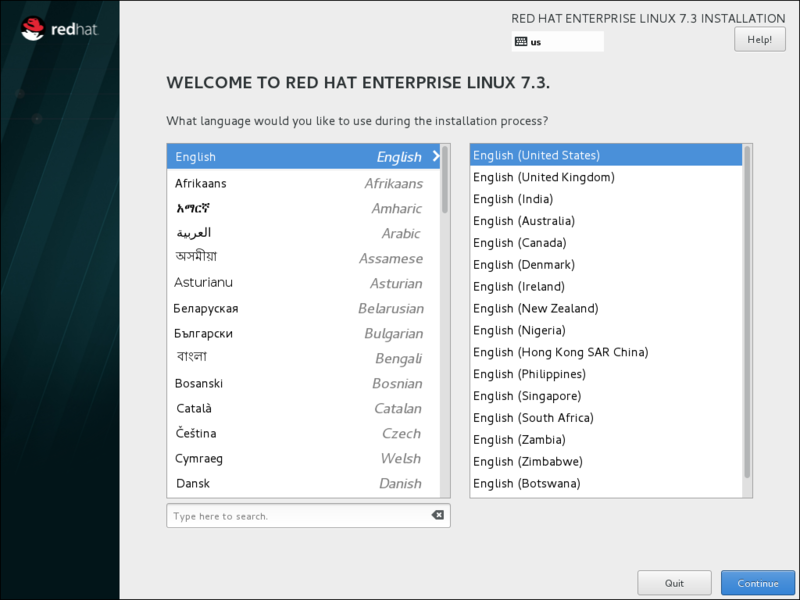
Step 3. Set Configuration Options
When you see the Installation Summary screen, you can set configuration options.
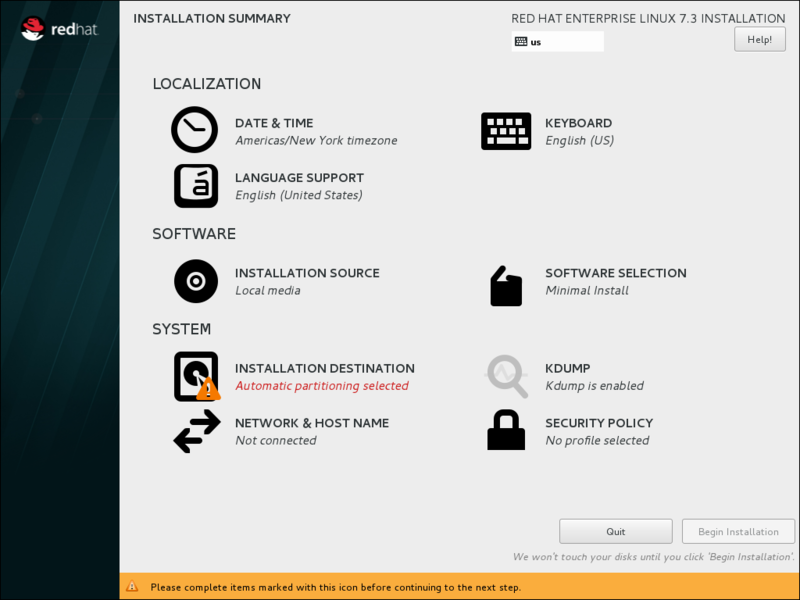
The various options can be displayed and changed in any sequence. No additional action is necessary if an automatic configuration option was set up properly. The setting for any things denoted by an exclamation point must be finished before you can start the installation, though.
Note: Up until the Start Installation button is clicked, nothing will be written to the disk.
Step 4. Select Date & Time
To continue to install RHEL in your time zone, enter your region and the closest city. To go back to the Installation Summary, click Done.
Step 5. Keyboard Layout Setup
On the Keyboard layout screen, follow the below steps to use what you prefer on your system.
- To add and remove keyboard layouts, press the + and – buttons.
- If you enable several keyboard layouts, use the button to move your chosen layout to the top of the list and make it the default.
- To go back to the Installation Summary, click Done.

Step 6. Select Installation Destination
- Choose the desired disk. The chosen target is marked with a checkmark.
- The chosen disk is automatically partitioned.
- To go back to the Installation Summary, click Done.

Step 7. Select Network & Hostname:
To select network and hostname:
- To activate the network settings, click the Ethernet sliding switch in the top right corner.
- To alter the network interface configuration, optionally choose the device and click Configure.
- To go back to the Installation Summary, click Done.
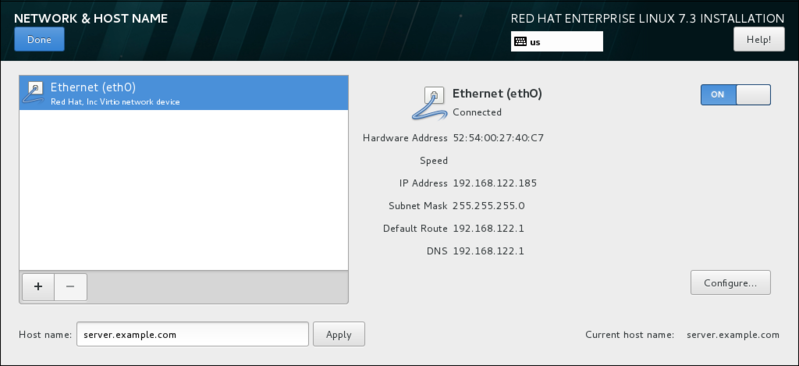
Note: The network settings are automatically applied by Anaconda. They are utilized both during and following installation.
Step 8. Configuration
To start the configuration, click Installation on the Installation Summary screen.
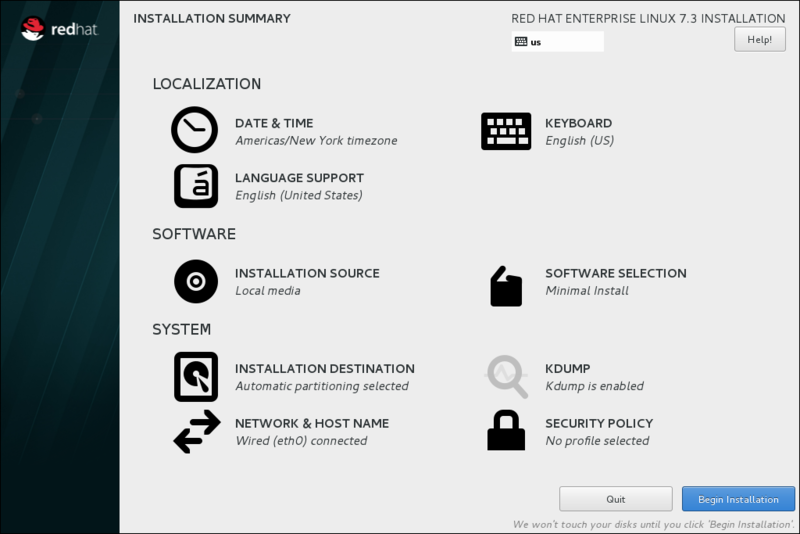
Step 9. View Configuration screen
When the Installation starts, you can view the Configuration screen. So, click Begin Installation on the Installation Summary.
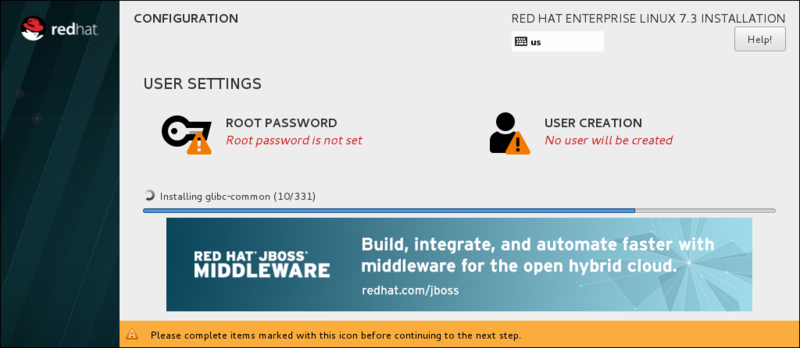
Then, follow the below steps during the installation:
Select Root Password.
Enter the password for the root user and confirm it.
Click Done to return to the Configuration screen.

Then, follow the below steps to create user.
- Choose “User Creation“
- Enter the user’s full name.
- Update the user name that was generated automatically, if desired.
- Confirm the password after setting it.
- Selecting the Make this user administrator checkbox is optional. By doing so, the user will be added to the
wheelgroup and be able to usesudowithout any additional setup. - To go back to the Configuration screen, click Done.
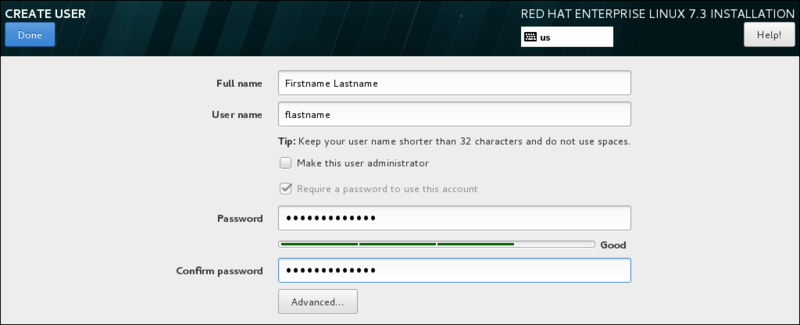
- Click Reboot after the installation is finished.
Step 10. Starting Installed System
The Initial Setup program launches automatically if the Server with GUI base environment was used during server installation. Then, accept the license agreement & register the system.
Final Note:
If during installation you chose any different base environment:
- Use root to access the system.
- Register the system and add a subscription automatically:
subscription-manager register --auto-attach \
--username=user_name --password=passwordWhat to Do After Installing RHEL?
When you finish installing Red Hat Enterprise Linux, you can the completion of the installation as well as any installation-related chores that you might carry out in the future. All you need to do is:
- Perform common post-installation tasks, such as registering the system to Red Hat Subscription Management services.
- Use a Red Hat Enterprise Linux installation disc to rescue a damaged system.
- Remove Red Hat Enterprise Linux from your computer.
FAQ
How to upgrade Red Hat system without removing the old version?
You can use the in-place upgrade method. Installing and using the migration utilities that are available for your system is necessary for the process.
How is the Red Hat Enterprise Linux storage connected?
It is connected by a standard internal interface, such as SCSI, SATA, or SAS.
How to use one disk space for Red Hat Enterprise Linux and another OS installed?
The disk space used by the operating system must be separated from the disk space used by Red Hat Enterprise Linux.
Conclusion
In this article, you learned How to Install Red Hat Enterprise Linux (rhel) in a visual method. Remember that you need at least 10 GiB of space, either in unpartitioned disk space or in partitions that can be erased, to install Red Hat Enterprise Linux.
If you follow the above 10 steps properly then you can smoothly install RHEL without any errors but do not hesitate to contact us if you encounter any problems. Our technical support team will try their best to solve your problems.